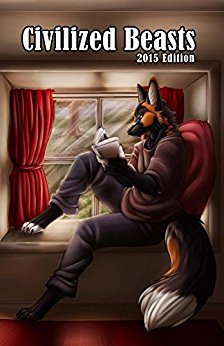Altered States, edited by Ajax B. Coriander – book review by Fred Patten.
by Patch O'Furr
Submitted by Fred Patten, Furry’s favorite historian and reviewer.
Altered States, edited by Ajax B. Coriander. Illustrated by Kuma.
Dallas, TX, FurPlanet Productions, June 2016, trade paperback $19.95 (319 pages), e-book $9.95.
This is a mature content book. Please ensure that you are of legal age to purchase this material in your state or region. (publisher’s advisory)
For the record, this book states inside that it is edited by three people; Ajax B. Coriander, Kodiak Malone, and Andres Cyanni Halden, two of whom also have a story in it.
Altered States is an erotic anthology of nine longish short stories and novelettes “of transformation and transmutation in many different flavors.” There is no introduction; the book gets right into it.
“Finishing Touches” by Ianus J. Wolf features Henry Wilson and his wife Carol. He’s a commercial artist who is commissioned to paint a rush-job cover for a fantasy novel whose original artist has defaulted at the last minute.
“He’d skimmed it quickly for visuals that might work, checking a few post-it notes from Ryan and the author at various pages. The novel itself wasn’t that inspiring, just another ‘band of unlikely heroes quests to destroy the evil power’ kind of thing. But now as he looked at hi own work, he felt he’d managed to get a pretty good image of noble citadel with banners flying and the silhouette of the evil wizard’s dark tower looming off in the background.” (pgs. 9-10)
Henry turns into an anthro wolf who can stand and talk without trouble. This multi-page scene is good but too long and detailed to quote. After a panicked WTF night, it turns out that Carol is a witch who has always wanted to have sex with a hunky wolf-man. Rawr! and Rawr! again. Henry adjusts to going out with Carol to furry conventions “in a really realistic fursuit”, and specializing in fantasy art using himself as the model for his wolf-men.



 Thousand Tales: Learning to Fly, by Kris Schnee
Thousand Tales: Learning to Fly, by Kris Schnee The Wayward Astronomer, by Geoffrey Thomas. Illustrated, map by David Lillie.
The Wayward Astronomer, by Geoffrey Thomas. Illustrated, map by David Lillie. The Wrath of Trees, by Bard Bloom. Illustrated, maps by Tod Wills.
The Wrath of Trees, by Bard Bloom. Illustrated, maps by Tod Wills. Redeeming Factors, by James R. Lane. Illustrated by Eugene Arenhaus.
Redeeming Factors, by James R. Lane. Illustrated by Eugene Arenhaus. The Laputan Factor, by Tristan Black Wolf. Illustrated by Dream and Nightmare.
The Laputan Factor, by Tristan Black Wolf. Illustrated by Dream and Nightmare. Animalis, by John Peter Jones
Animalis, by John Peter Jones The Time He Desires, by Kyell Gold. Illustrated by Kamui.
The Time He Desires, by Kyell Gold. Illustrated by Kamui. Civilized Beasts, Poetry Anthology, 2015 Edition, editor-in-chief Laura Govednik.
Civilized Beasts, Poetry Anthology, 2015 Edition, editor-in-chief Laura Govednik. The Earth Tigers, by Frances Pauli
The Earth Tigers, by Frances Pauli